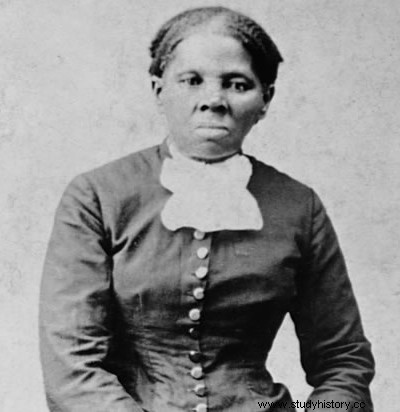Escaped slave, Araminta Ross, known as Harriet Tubman (between 1820 and 1825 – 1913) was a human rights activist, who participated in many ways in the fight against slavery and racism.
The violence of the masters
 Araminta Ross was born between 1820 and 1825 on a plantation in Maryland (USA), to slave parents, Harriet Green and Ben Ross; Araminta is the fifth of nine children, but her three older sisters are sold and separated from their families forever. When Edward Brodess, owner of the plantation and his slaves, wishes to sell the youngest son of the family, Harriet Green resists him with determination and obtains the abandonment of the sale.
Araminta Ross was born between 1820 and 1825 on a plantation in Maryland (USA), to slave parents, Harriet Green and Ben Ross; Araminta is the fifth of nine children, but her three older sisters are sold and separated from their families forever. When Edward Brodess, owner of the plantation and his slaves, wishes to sell the youngest son of the family, Harriet Green resists him with determination and obtains the abandonment of the sale.
Araminta, nicknamed "Minty", quickly takes care of her younger siblings. From the age of five or six, she is sent to work with different masters, where she is frequently beaten and whipped. As a teenager, she received a violent blow to the head instead of a slave running away, and suffered lifelong consequences. All her life, she will have seizures and fainting spells. Very religious, she will also have visions and dreams that she will interpret as divine signs.
The conquest of freedom
Growing up, she chose to take the name of Harriet, certainly in homage to her mother, and married John Tubman, a free man, around 1844. She began to fear being sold and, after the death of her owner, tried a first escape on September 17, 1849. She left with her brothers Ben and Henry, her husband refusing to follow her, but her two brothers were seized with fear and forced Harriet to return with them. Shortly after, she escapes again, this time alone. With the help of Quakers and abolitionist sympathizers, she manages to reach Pennsylvania, where slavery has been abolished for 80 years.
Moses of the Black People
Free, Harriet Tubman immediately thinks of her family still enslaved. In Philadelphia, she works and saves money in a situation that is not without risk:all states, even those that have abolished slavery, must collaborate to capture fugitive slaves. In December 1850, Harriet learned that her niece and her children were to be sold and separated from their families. She then returns to Maryland to help them escape and reach Philadelphia. She will return there later to look for her husband, but he has remarried in the meantime and refuses to follow her. She then helps her four brothers and other slaves to escape to Pennsylvania and Canada. In thirteen expeditions, she guides about seventy slaves to freedom and earns the nickname "Moses of the Black people".
The Civil War
At the start of the Civil War, in 1861, Harriet Tubman enlisted in the war. She serves as a cook and nurse in military camps and then leads a group of spies. With a group of scouts, she was doing reconnaissance to map the unknown terrain. It participates in the organization of raids against plantations and is present during assaults.
After the war, Harriet became an activist for human rights, particularly African American and women's rights; she campaigned in particular for women's right to vote, alongside Susan B Anthony. In 1869, helped by a biographer, she saw her story published under the title Scenes from the Life of Harriet Tubman . The same year, she married a war veteran, Nelson Davis.
Harriet Tubman died on March 10, 1913. She received military honors. She is enshrined in the National Women's Hall of Fame.
